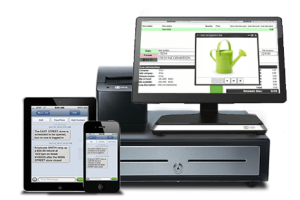How To Go From Day-to-Day Management to Fast Growth
Picture the year-long rhythm of your garden center: the frantic energy of spring Saturdays when carts overflow with color, the quieter midsummer weeks when you’re adjusting displays and shifting promotions, and the late evenings spent reconciling what sold and what didn’t.
You’ve already proven you can run a garden center. You know the demands, the joys, and the pressure points of the business.
But now you’re asking a different question: how do I grow faster?
Growth isn’t about reinventing what you’ve built; it’s about refining it.
You need to improve systems so inventory doesn’t keep you awake at night, create experiences that keep customers coming back year-round, and use the right tools to turn seasonal highs and lows into steady, reliable profit.
This article will guide you through proven strategies for growing a garden center business you already own, helping you move from managing day-to-day survival to scaling long-term success.
Revisit Your Business Plan Yearly
Many owners think of a “business plan” as a start-up tool. But for established centers, business plans function as a growth accelerator. Reviewing your plan each year forces you to ask: Are we still meeting the needs of today’s customers? Are we prepared for the shifts in gardening trends and community expectations?
Consider the surge of houseplant sales in recent years. Many garden centers that once focused on outdoor plants almost entirely grew revenue by catching this trend and then dedicating space to indoor collections, care kits, and workshops. Reassessing your mix regularly keeps you aligned with what customers actually want.
Look closely at these three areas:
- Reevaluate your product mix: Add trending, high-margin categories like indoor plants, pollinator-friendly selections, and/or eco-conscious products.
- Reassess your customer demographics: Are younger first-time homeowners buying from you? Are landscapers requesting bulk? Adjust your offerings accordingly.
- Invest in staff expertise: Seasonal training refreshers keep your team confident and your customers loyal.
It’s worth noting that this isn’t just about chasing trends. According to the People and Nature Survey, 43% of people said green spaces were vital to their well-being after the 2020 pandemic. That’s a market shift worth re-centering your offerings around.
(Do you not have the data on your sales? Click here to learn more about garden center point of sales.)
Create a Space That Sells More Using ‘Experiences’
Think about your customer’s mindset. They aren’t just buying a rose bush or a flat of petunias, they’re buying the dream of a summer evening on the patio, or a yard that feels welcoming again after a long winter. Your job is to translate their feelings into displays that inspire purchases.
The most successful garden centers don’t just line up plants on tables; they create experiences.
Seasonal displays that group complementary plants and accessories encourage customers to picture (and purchase) an entire solution, not just one item. One owner told us they began arranging late-summer displays with drought-tolerant plants, paired with irrigation tools and signage about water conservation. Not only did sales rise, but customers thanked them for helping solve a real seasonal challenge. That’s growth: increasing average basket size while also adding value.
The data also suggests you shouldn’t underestimate the power of first impressions. Customers often decide whether they’ll linger within the first ten seconds of walking through your doors. A burst of color, a carefully staged display, or even an unexpected focal point can set the tone for the entire shopping experience: inviting them to slow down, explore, and ultimately buy more.
Scale Up Your Inventory Management With Dedicated Software
Inventory is the lifeblood of your center, but it’s also where money gets tied up. Owners often tell us, “I know I’m losing profit somewhere, but I can’t see where.” Moving beyond instinct into insight is how you scale up.
Imagine this: it’s mid-May, your busiest season, and customers are lining up for your signature hanging baskets. But the tables are already bare; they sold out a week earlier than expected. Not only do you lose immediate sales, but disappointed customers may head to a competitor. On the flip side, over-ordering leaves you with perennials lingering into the heat of July, forcing deep discounts that cut into margins.
Growth-minded garden centers prevent those headaches by tightening how they manage stock. A few practical shifts can make the difference between missed opportunities and steady growth:
- Use seasonal sales data to avoid overstocking or stock-outs. For example, track when hanging baskets typically sell out in spring, and plan accordingly.
- Diversify offerings beyond plants: tools, décor, and consumables like soil or fertilizer can stabilize revenue.
- Adopt POS-powered visibility so you can spot shrinkage, dead stock, or bestsellers instantly.
- Schedule mid-season reviews to pivot before small issues become costly.
And the results are real: garden centers that integrate supplier ordering with their POS end up saving time and greatly reducing costly errors in inventory management. That means fewer surprises on the shelves and fewer disappointed customers walking away empty-handed.
Instead of walking the aisles late at night with a clipboard, you can be making proactive decisions because your system is doing the counting for you.
The Data Is Clear: Grow Loyalty For Higher Returns
The customers who already shop with you are your greatest growth opportunity. Acquiring a new customer can cost five times more than retaining an existing one, which means the real secret to growth is deepening relationships with the people who already trust you.
Think of the customer who stops in for a bag of soil but ends up joining a Saturday workshop. They leave not only with what they came for, but also with a sense of belonging and a reason to come back. In that moment, they’re no longer just a shopper, they’re part of your story.
Experiences are one of the most effective ways to do that. A Pennsylvania nursery, for example, built a loyal following through a “Junior Gardening Club” that turned kids into budding gardeners and parents into long-term customers. There are stories of other centers hosting seasonal workshops, like succulent potting in winter or herb growing in spring. This not only generates extra revenue but also positions the business as a gathering place for the community.
Owners who want to expand loyalty often start with a few simple, high-impact steps:
- Host seasonal workshops that engage both new and repeat visitors
- Create a kids’ program or family-friendly series that “plants roots” for future customers
- Reward regulars with points, perks, or early access to seasonal stock
This payoff is measurable. Studies show that loyalty members in retail spend 12–18% more per year than non-members. Apply that to your own customer base, and the numbers quickly add up not just to sales, but to stronger word-of-mouth and deeper community ties.
Tell Your Growth Story Online
For many potential customers, your first impression happens online, not in your aisles. If you want to grow, your digital presence needs as much attention as your plant displays.
Customers are 70% more likely to visit a business with an updated Google listing. Updating your Google Business Profile with photos of seasonal arrivals boosts visibility and drives local foot traffic. Social media, when done consistently, keeps you in the customer’s mind even when they’re not actively shopping. And email remains one of the most cost-effective growth tools for retail, delivering an average $36 return for every $1 spent.
A few simple habits can turn your digital presence into a growth engine:
- Update your Google Business Profile monthly with fresh, seasonal photos
- Post short, authentic videos weekly: staff tips, new arrivals, or behind-the-scenes prep
- Send a monthly email featuring upcoming events, promotions, and plant care advice
For garden centers, those seasonal photos of tulips in April or poinsettias in December aren’t just attractive, they’re an invitation that converts into visits and sales.
Use Garden-Specific Technology For Faster Growth
When margins are tight and seasons are unpredictable, technology is what allows you to scale without losing control.
And a garden-specific sales system like Rapid Garden POS helps you grow smarter. With real-time reporting, you can see at a glance which promotions drive revenue, which plant categories are underperforming, and whether loyalty programs are increasing repeat visits. Instead of guessing, you’re making data-driven decisions.
The benefits extend beyond reporting. With mobile POS, staff can check out a landscaper directly in the yard while they’re loading bulk soil, or process a payment at a spring fair booth without sending the customer back inside. Those small conveniences build trust and loyalty while also increasing throughput during peak rushes.
And don’t underestimate the ripple effects! Streamlining reordering reduces costly stock-outs, integrated ecommerce makes online sales seamless, and CRM integrations allow you to tailor promotions based on customer purchase history.
Put all together, choosing your POS is as important as choosing your suppliers. For growth-minded owners, it’s not just about transactions; it’s about clarity, control, and the confidence to make bigger moves.
Grow in the Fall, Not Just in Spring
Most owners agree: spring pays the bills. But growth means smoothing out the peaks and valleys from the rest of the year. The strongest garden centers design a 12-month rhythm that keeps revenue flowing in all seasons.
There is no model that is one-size-fits-all, but here is a good framework for a typical garden center:
- Spring: Launch workshops, pre-orders, and community planting events
- Summer: Highlight outdoor décor and water-saving tools
- Fall: Shift to indoor plants, bulbs, and seasonal décor
- Winter: Focus on gift cards, holiday greenery, and houseplant bundles
Garden centers that embrace this kind of seasonal diversification (expanding into non-plant categories like décor, gift items, and even cafés) attract a wider customer base and reduce dependence on a single busy season. The more reasons you give customers to visit throughout the year, the steadier and more resilient your revenue becomes.
Think of it as gardening for your business: the more you plan for each season, the stronger and more adaptable your garden center grows.
_____________
Growing With the Right Partner
Running a garden center takes grit and heart. You’ve weathered spring rushes, endured quiet midsummer afternoons, and built connections with customers who trust you to guide their choices. You’ve proven you can run a successful business.
But growth is something different. It’s about refining what already works, finding steadier rhythms through every season, and giving your team the tools to serve customers with confidence. It’s about turning long days of manual juggling into clear, simple decisions that free you to focus on the bigger picture.
At Rapid Garden POS, we have unmatched experience in meeting those challenges, because we built our system for garden centers just like yours. From real-time inventory clarity to mobile checkout in the yard, from loyalty programs to year-round reporting, we’re here to help you move beyond day-to-day management into true, sustainable growth.
Because at the end of the day, your business should grow with the same resilience and beauty as the plants you sell: season after season, year after year.
If you think your garden business has room to grow, schedule a time to see how Rapid Garden POS will scale your garden center with confidence — Book Your Free 1:1 Demo.




